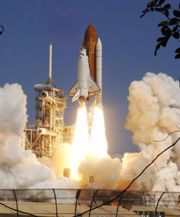 |
| NASA successfully launched space
shuttle Discovery on Tuesday, but anxiously reviewed video
showing debris falling from the craft during liftoff, the same
problem that caused the fatal Columbia
disaster 2-1/2 years
earlier. | |
NASA successfully launched space shuttle Discovery
on Tuesday, but anxiously reviewed video showing debris
falling from the
craft during liftoff, the same problem that caused the fatal Columbia
disaster 2-1/2 years earlier.
The debris did not appear to hit the shuttle during the smooth morning
blastoff, marking a triumphant U.S. return to manned space travel after
the long struggle to recover from Columbia's breakup over Texas.
Engineers hoped to know by Sunday whether Discovery was damaged and
whether the crew should attempt repairs, flight operations manager John
Shannon said.
A chunk of foam from an external fuel tank hit Columbia's wing during
liftoff on Jan. 16, 2003, and caused a breach that tore the shuttle apart
when it reentered Earth's atmosphere 16 days later. All seven astronauts
aboard were killed.
Discovery, also carrying seven crew members, soared into slightly hazy
skies on Tuesday, leaving behind a trail of smoke and flames, while the
roar of its booster rockets rattled windows and shook the ground across
Cape Canaveral in Florida.
"I want to ask you all to take note of what you saw
here today," said NASA's new administrator Michael Griffin, basking in a
palpable
sense of
relief that swept through the launch management team after Discovery
safely reached orbit.
"The power and the majesty of the launch, of
course, but also the competence and the professionalism, the sheer gall,
the pluckiness, the grittiness
of this team that pulled this program out of the depths of
despair two years ago and made it fly."
Discovery's main mission on the 12-day space flight under veteran
astronaut Eileen Collins is to test new safety measures and heat shield
repair techniques introduced since sister ship Columbia disintegrated on
Feb. 1, 2003.
An unprecedented array of 112 cameras, radars and sensors was set up to
monitor Discovery's launch. One showed what may have been a small chip
from an insulating tile falling off the underside of the shuttle's nose
cone, Shannon said.
Another seemed to show a larger piece of debris peeling off the
exterior fuel tank. Mission control officials at Johnson Space Center in
Houston said technicians would analyze the data "frame by frame" to see if
there was any damage.
Discovery's other main mission is to deliver several tonnes of supplies
and equipment to the International Space Station, whose construction has
been on hold since the remaining three shuttles were grounded in the
aftermath of Columbia.
Discovery's launch was delayed for two weeks while
engineers searched for the cause of an elusive
problem with one of its hydrogen fuel-level sensors during the first launch attempt on July 13.
(Agencies) |
本周二(7月26日),美国宇航局成功地把“发现”号航天飞机送入太空,但是又忐忑不安地仔细研究监控航天飞机发射升空的录像带。录像带显示,当航天飞机发射升空时,有碎片从飞船上脱落。而导致两年半前“哥伦比亚”号惨剧的正是同样的问题。
周二早上进行的发射比较顺利,碎片并没有击中航天飞机。自从“哥伦比亚”号在德克萨斯州上空解体爆炸后,美国长时间以来一直努力恢复载人太空飞行,“发现”号的顺利升空也标志着美国这方面的努力取得成功。
飞行操作主管约翰·沙农表示,工程师要到本周日才能知道“发现”号是否受损,以及机组成员是否应进行维修。
2003年1月16日,“哥伦比亚”号在点火升空时,一大块泡沫材料从外挂燃料箱脱落,击中了飞机的左翼,造成一个裂口。正是由于这个裂口,16天后“哥伦比亚”号在返回地球大气层时解体爆炸,7名机组成员全部遇难。
本周二,同样载有7名机组成员的“发现”号再次发射,身后拖着长长的浓烟和烈焰,升入雾蒙蒙的天空。助推火箭的巨大的轰鸣声震得佛罗里达州卡纳维拉尔角附近的窗户嗡嗡作响,大地颤动。
在“发现”号安全进入预定轨道之后,整个发射管理团队如释负重。美国宇航局新任局长迈克尔·格里芬(Michael
Griffin)也长舒一口气,说,“我希望你们能够记住今天所看到的一切。”
“你们要记住这次宏伟壮丽的发射,当然还有这个发射管理团队的专业水平、敬业精神、无畏的胆量和勇气,以及他们坚韧不拔的意志。正是这个团队使发射计划走出两年前失败的阴影,使‘发现’号顺利升空。”
“发现”号航天飞机预定进行为期十二天的太空飞行,由资深航天员艾琳·柯林斯负责指挥。飞机的主要任务是测试新的安全措施和隔热挡板修理技术。在“发现”号的姊妹机“哥伦比亚”号于2003年2月1日发生解体之后,美国宇航局引入了这些措施和技术。
在“发现”号发射的过程中,共有112部摄像机、雷达和传感器负责监控,可谓是史无前例。沙农透露,其中的一部摄像机拍摄到一小块隔热瓦从航天飞机头锥外部脱落。
另外一部摄像机还拍摄到有一块更大的碎片从飞机外挂燃料箱脱落。休斯敦约翰逊航天中心的飞行任务控制官员说,技术人员将会一帧一帧地分析相关数据,以检查飞机是否受损。
“发现”号的另外一个主要任务就是向国际空间站运送数吨重的补给和设备。自从“哥伦比亚”号惨剧发生之后,其余的三架航天飞机就一直停在地面上,国际空间站的建设也不得不暂停。
“发现”号原定于7月13日发射,但是由于其中一个液氢燃料传感器发生故障,工程师花费了两个星期来寻找造成这个难题的原因,“发现”号也不得不推迟至本周二发射。
(中国日报网站译) |
